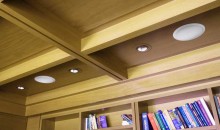Taming Bright Speakers and Reverberant Rooms
Have you ever been in a room where the audio, be it music or a movie soundtrack, sounds really “tinny” or “crisp”? It’s what we refer to in the industry as “bright”. Taming bright speakers is a big deal if you want to maintain clarity without achieving a harsh or unruly sound. While a loudspeaker can be responsible for this, it can also be the effects of a room. A room can also “muddy” the sound by creating a reverberant effect that reflects the sound back into itself over and over again. Most rooms aren’t large enough to create an actual echo, but if they are made of concrete, hard surfaces, and lots of glass, the effects can be detrimental to your listening enjoyment.
Identifying If You’re Taming Bright Speakers or a Bright Room
The first thing we recommend is determining whether it’s your room that’s creating the brightness of the sound—or your speakers. I always start with the room. It’s also a dead giveaway if you have lots of glass and hard reflective surfaces, and very little to dampen the sound or reduce acoustical reflections.
What are Acoustical Reflections?
When sound is generated by a speaker, it doesn’t just move directly to your ears and stop. It disperses into the room and spreads out. Some of the audio goes directly to your ears, while other audio hits all of the surfaces around the room (bouncing here and there) and is reflected to your ears—slightly delayed from the original. This is absolutely normal, and in most rooms, this doesn’t present a problem until you get into a situation where the reflected sounds are coming back to you with an intensity and clarity that messes with the original source. These reflections are what you want to minimize and control.
Before you can identify how much your room has to do with anything (or whether you’ll end up taming bright speakers), you’ll need to understand the difference between reflection, dispersion, and absorption when it comes to audio. Here’s a quick way to identify the various items in your room that have the characteristics of being either reflective, absorptive, or dispersive:
Reflective items
- Glass coffee or end tables
- Terrazzo, tile or hardwood floors
- Large windows
Dispersive items
- Randomly filled bookshelves
- Trinket shelves
- Leather furniture
Absorptive items
- Fabric curtains
- Cloth furniture
- Acoustical tile ceilings
- Carpeted floors
- Acoustic panels
What You Can Do to Tame a Bright Room
To reduce the brightness of a room, there are several steps you can take. The following outlines our recommendation on assessing and modifying a room without making major, fundamental and expensive changes that would require hiring an outside contractor!
Step 1: Identify Floor Surfaces That Can Be Covered
Take a look around your room and identify whether or not you have a reflective floor. In particular, the area between your center speaker and your sitting position may need to have something to help alleviate those hard reflections coming off dialogue and most of the sound in a movie that isn’t panned hard left or right. I’m a big fan of throw rugs. They’re not terribly expensive and they can actually help make a room more cozy and welcoming. I’ve been thanked several times by wives who loved the fact that I encouraged their husbands to go out and purchase a rug they never would have thought of on their own!
Step 2: Identify Furniture That May Be Causing Direct Reflections
Another culprit to bright sound is a coffee table or other piece of furniture that is directly in the path of either your center channel speaker or your main speakers. If it has a glass top, chances are it’s at least contributing to the problem. Since we’re dealing with higher frequency sounds, a nice folded cloth or other similar material placed on the furniture piece can greatly reduce the effect. Of course, moving the furniture around a bit may also help alleviate having a reflective surface in the listening path.
Step 3: Examine Your Walls and Windows
I was once made aware of a major manufacturer who would test their speakers in a room that had a massive glass wall. It was insane, and certainly not the listening environment I’d select if there was any way around it. If you have large windows that are located to the sides or back of the room, then you may want to invest in some curtains or fabric blinds that can somewhat lessen the effect of the reflected sound coming off those surfaces. It may be an investment—but once again, we often hear a big “thank you” from clients who are suddenly given an excuse to “fluff up” their window treatments!
Hanging pictures on bare walls won’t do much but altering the layout of books in a bookshelf can help reduce the number of harsh reflections in a room. A bookshelf of neatly stacked books all in a row won’t do much for your cause. Lay some down and play with the various depths and positions, however, and you’ve just created a natural diffusor. Those cost lots of money in the real world—so why not experiment with rolling your own in the easiest way possible!
Step 4: Add Absorption
The number one way to tame a bright room is to add some absorption. While many envision these panels as the egg cartons often seen in movies, it doesn’t have to be (and honestly, egg cartons and foam do very little to help). Absorption panels can be made in various shapes and sizes and covered with fabric that can match your room color or accent your decor. They can even have printed images on them that can be hung instead of art or photos. These panels will do the most to tame the reflections in your room.
Finally, Look at Taming Bright Speakers
If, after all of this, you still feel as if your loudspeakers are the culprit, it’s still not hopeless. The first thing you want to do is notice how your speakers are positioned. If they are pointed directly at you, taming bright speakers might mean those tweeters need to be angled in more of a parallel arrangement. This is tricky because it also affects the soundstage—the way in which what you are listening to is represented in the space in front of you. Still, there is often some leeway and compromise to be had in speaker positioning, particularly when you’re dealing with an overly bright system.
One thing we don’t really recommend in taming bright speakers is adjusting the broad “treble” controls on our AV or stereo receiver. Those controls adjust a very wide spectrum of sound and it’s more likely that you’ll go from a bright system to one that is inaccurate along the broadest range of higher frequencies above the midrange. Some receivers these days have parametric EQs or other sound-altering features. Again, we don’t recommend these unless you are willing to do measurements. Too often, these adjustments do more harm than good.
Wrapping It All Up
First, notice the floors and ceilings and add or adjust as much as possible. Then, notice your furniture and see if you can move or adjust in that area as well. Finally, look at your walls and windows to see if there are massive areas of high reflectivity there. Lastly, you can experiment with the toe-in of your speakers to see if you can take those tweeters a bit more off-axis, thus dropping the effective output that hits your ears at the peak frequencies. There’s also a discussion as to the materials used in tweeters: aluminum vs. soft dome and silk. The bottom line is that we’ve experienced excellent sound from all kinds of tweeters, so the answer is definitely more involved than simply identifying the materials used in high-frequency driver production.
Did we forget any tips on taming bright speakers? If we did, feel free to leave us a comment below or jump into on our ongoing Facebook discussion.









A quick, simple and easy remedy is to insert a fixed value ceramic resistor in series on the live feed to your speakers’ tweeters. A wide range of values is available and they’re dead cheap, so start with 1 ohm (the first I tried and which turned out to be exactly right) and go from there. No need (unless you really want to) to mess about with room treatments and expensive cables.
Ha—a poor man’s EQ!
You are missing the four worst contributors to a bright, harsh sounding room: The ceiling and the primary reflection points behind the speakers and to each side of the speakers. Especially the ceiling does not need diffusion, it needs absorption preferably in the form of efficient absorbers like Ecophon or Rockfon. Adding three 1200 x 1800 x 40 mm Ecophon Solo absorbers to the ceiling has completely changed the room. The sub had to be turned down 4 dB to compensate for the now absent reverberation in the midrange. The reflection point on the rear wall and the area behind the center speaker has been treated with just 20 mm thick Ecophon.
Question: Would changing from 16 gauge wire to 14 gauge help?
In a word, no. Unless your speakers are miles from you, the gauge shouldn’t make an audible difference. We generally recommend no higher than 14 gauge but 16 should be fine for nearly any home theater setup.